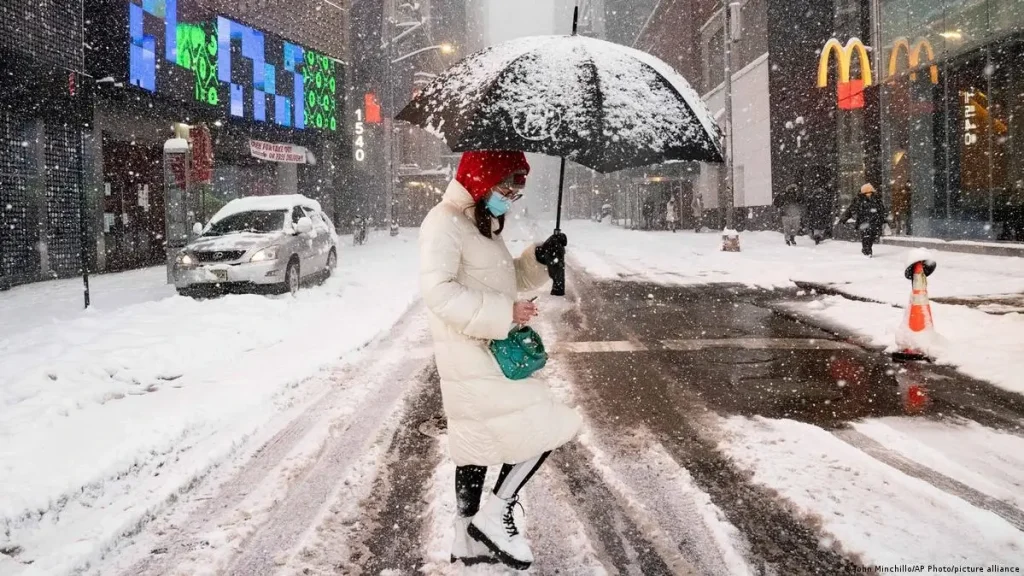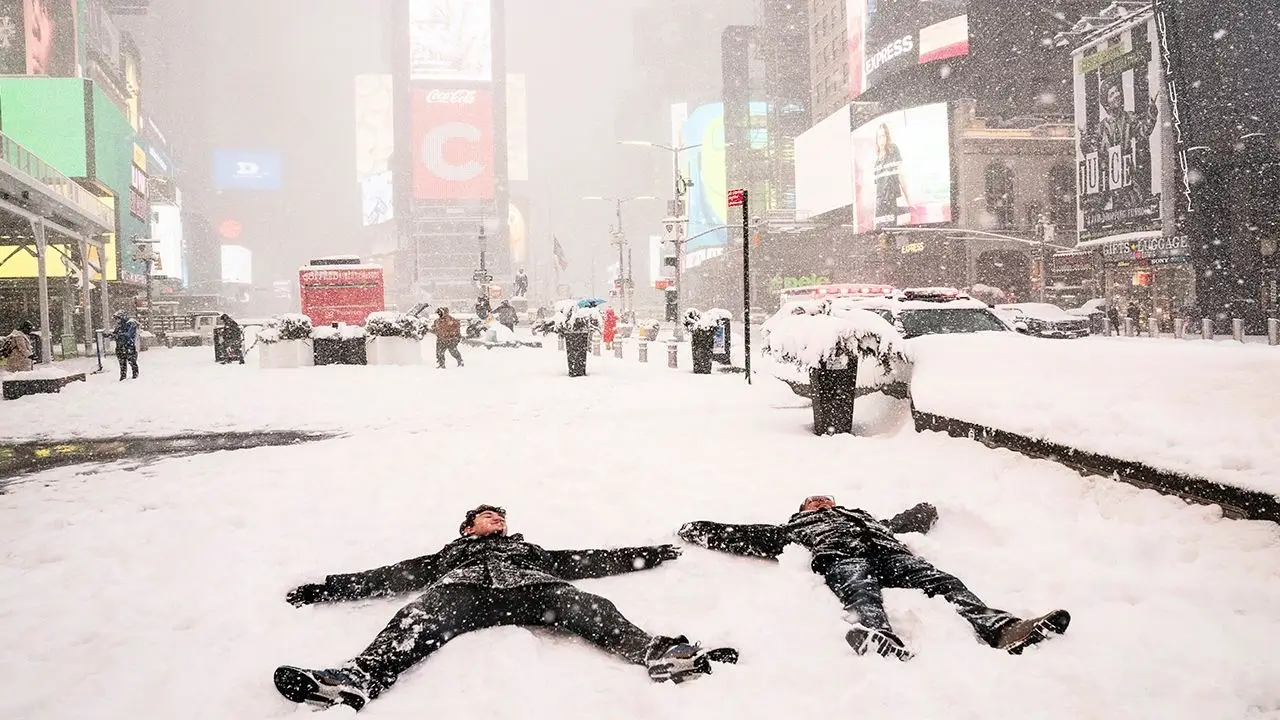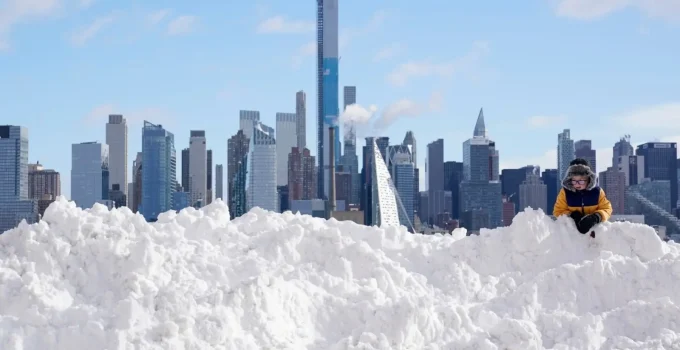Get ready, New Yorkers! Winter is just around the corner, and with it comes the uncertainty of snowstorms. While some see it as a picturesque wonderland, others brace themselves for the impact it can have on their daily lives. In this article, titled ‘Brace for Impact: NYC’s Winter Wonderland or Warning? Navigating the 2024 Snowstorm’, we will explore the challenges and opportunities that come with the snowy season in the Big Apple.
This article will provide valuable insights on how to navigate the city when the snow starts falling. From tips on commuting to work and avoiding transportation disruptions to the best places for winter activities, we’ve got you covered. Whether you’re a tourism enthusiast or a New Yorker looking for ways to make the most out of the winter season, this article has something for everyone.
Join us as we dive into the excitement, beauty, and potential chaos that snowstorms bring to NYC. Discover how this winter wonderland can be both a delight and a warning, and gain the knowledge you need to navigate the 2024 snowstorm with confidence. Don’t let winter catch you off guard – be prepared and embrace the snowy adventure that awaits!
Understanding the impact of snowstorms in NYC
New York City is no stranger to snowstorms. Every winter, the city experiences a significant amount of snowfall, sometimes resulting in blizzard-like conditions. The impact of these snowstorms goes beyond the inconvenience of shoveling snow and slippery sidewalks. Snowstorms can disrupt transportation, close schools and businesses, and even pose safety risks to residents. Understanding the potential impact of snowstorms is key to being prepared and minimizing any negative consequences.
Snowstorms can affect various aspects of city life. One of the most significant impacts is on transportation. When heavy snowfall occurs, it becomes challenging for buses, subways, and other forms of public transportation to operate efficiently. Delays and service disruptions are common, causing inconvenience for commuters. Additionally, snow-covered roads can make driving hazardous, increasing the risk of accidents. It is crucial for residents to plan their travel accordingly during a snowstorm and stay updated on the latest transportation advisories.
Another area affected by snowstorms is the city’s infrastructure. New York City has a robust snow removal process in place to ensure the streets and sidewalks are cleared promptly. However, the sheer volume of snowfall during a severe storm can put a strain on these resources. The efficiency of snow removal operations can vary depending on the intensity and duration of the storm. It is important for residents to be patient and cooperative during snow removal efforts to facilitate the process and ensure everyone’s safety.
Snowstorms also impact the daily activities of businesses and residents. Schools may be closed, forcing parents to find alternative child care arrangements. Businesses may experience reduced foot traffic, affecting their revenue. Residents may face difficulties in accessing essential services and supplies. Being prepared for these potential disruptions can help mitigate their impact. Stocking up on essential supplies, making alternative work arrangements, and having a contingency plan in place can make navigating the snowstorm more manageable.

Preparing for a snowstorm: Winter weather safety tips
When a snowstorm is on the horizon, it’s crucial to be prepared and prioritize safety. Here are some winter weather safety tips to keep in mind:
- Stock up on essentials: Make sure you have an ample supply of food, water, medications, and other essential items to last several days. Power outages and disruptions in services can occur during a snowstorm, so it’s essential to be self-sufficient.
- Prepare your home: Insulate your home to conserve heat and prevent drafts. Clear snow from your roof to avoid structural damage. Have a backup heating source and ensure your smoke and carbon monoxide detectors are working correctly.
- Dress appropriately: Layer your clothing to stay warm and protect yourself from the cold. Don’t forget to wear a hat, gloves, and a scarf to prevent heat loss from your body.
- Travel with caution: If you must travel during a snowstorm, exercise caution and allow extra time for your journey. Clear snow and ice from your vehicle before driving, and maintain a safe distance from other vehicles. Avoid unnecessary travel if conditions are hazardous.
- Stay informed: Keep track of weather updates and advisories from reliable sources. Stay tuned to local news channels and follow official social media accounts for the latest information. Be aware of any emergency alerts or evacuation orders.
Remember, the key to staying safe during a snowstorm is to be prepared and use common sense. Stay indoors if conditions are dangerous and only venture out when necessary. Your safety should always be the top priority.
NYC’s snow removal process and infrastructure
When it comes to snow removal, New York City has a well-established process in place to keep the streets and sidewalks clear. The Department of Sanitation (DSNY) is responsible for snow removal operations and works tirelessly to ensure the city can function as smoothly as possible during and after a snowstorm.
The snow removal process begins as soon as snow starts falling. DSNY deploys a fleet of salt spreaders and plows to treat and clear the roads. Priority is given to major streets, highways, and bus routes to ensure they remain passable for emergency vehicles and public transportation. Once these primary routes are cleared, attention is shifted to residential streets and sidewalks.
Clearing snow from sidewalks is the responsibility of property owners, including residents and businesses. Failure to shovel sidewalks within a certain timeframe can result in fines. However, during significant snow events, the city may provide additional assistance to ensure sidewalks are passable for pedestrians.
The snow removal process is a massive undertaking involving coordination between various city agencies. It relies on a combination of manpower, equipment, and technology to clear snow from the city’s vast network of streets and sidewalks. The efficiency of the process may vary depending on the severity of the storm, but the goal is to restore normalcy as quickly as possible.
It is important for residents to be patient and understanding during snow removal operations. Clearing snow from the entire city is a time-consuming task, and it may take several days for all areas to be fully cleared. Cooperation from residents in clearing their sidewalks and not obstructing plows can significantly expedite the process.
Navigating transportation during a snowstorm
Snowstorms can wreak havoc on New York City’s transportation system. Buses and subways may experience delays or service suspensions, making it challenging for commuters to reach their destinations. It is essential to plan ahead and be prepared for potential transportation disruptions during a snowstorm.
Before heading out, check for any service advisories or delays on the MTA website or through their official social media accounts. Sign up for text or email alerts to receive real-time updates on any changes to the transportation schedule. Consider alternative routes or modes of transportation if necessary.
If you rely on public transportation, allow extra time for your commute. Delays are common during snowstorms, and crowded platforms or buses are not uncommon. Dress warmly and wear appropriate footwear to navigate potentially slippery conditions. Be patient and understanding towards transit employees who are working hard to keep the system running smoothly.
For those who drive, it is crucial to adapt to the conditions and exercise caution. Clear snow and ice from your vehicle before driving and maintain a safe distance from other vehicles. Avoid sudden braking or accelerating to prevent skidding on slippery roads. Consider using public transportation or carpooling if driving conditions are hazardous.
Cycling and walking during a snowstorm can be challenging, but with proper precautions, it can still be a viable option. Dress warmly and wear reflective clothing to ensure visibility. Use designated bike lanes where available, and walk on cleared sidewalks whenever possible. Be mindful of icy patches and exercise caution to avoid accidents.
During a snowstorm, it is essential to stay informed and have a backup plan in case your usual mode of transportation is disrupted. Consider telecommuting or working from home if possible to avoid unnecessary travel. Prioritize your safety and choose the transportation option that best suits the conditions.
Winter activities in NYC: Embracing the snow
Despite the challenges snowstorms may bring, they also offer opportunities for unique winter activities in New York City. Embracing the snow can turn a potentially stressful situation into a memorable adventure. Here are some popular winter activities to consider:
- Ice skating: Lace up your skates and head to one of NYC’s many ice rinks. From the iconic Rockefeller Center to Central Park’s Wollman Rink, there are plenty of options to choose from. Embrace the winter wonderland and glide across the ice surrounded by the city’s skyline.
- Sledding: Grab a sled and head to one of the city’s designated sledding hills. Prospect Park, Central Park, and Fort Greene Park are just a few places where you can experience the thrill of sledding down a snowy hill. Don’t forget to bundle up and bring hot cocoa to keep warm!
- Snowshoeing: Explore the city’s parks and trails on snowshoes. Strap on these specialized shoes and venture into the winter landscape. From Pelham Bay Park in the Bronx to Alley Pond Park in Queens, there are plenty of opportunities to experience nature in a unique way.
- Winter festivals: NYC is known for its vibrant festivals, and winter is no exception. From the Winter Village at Bryant Park to the Lunar New Year celebrations in Chinatown, there are numerous cultural events and festivals to enjoy during the snowy season. Immerse yourself in the festivities and embrace the diversity of the city.
- Winter photography: Snow-covered streets and iconic landmarks provide the perfect backdrop for photography enthusiasts. Capture the beauty of the city in its winter coat and create lasting memories. From the Brooklyn Bridge to Times Square, there are endless opportunities for stunning winter shots.
Winter activities in NYC offer a chance to embrace the snow and make the most out of the winter season. Whether you prefer adrenaline-pumping adventures or peaceful walks in the snow, there is something for everyone to enjoy. So grab your winter gear and get ready to experience the magic of NYC’s winter wonderland!
The economic impact of snowstorms on NYC
Snowstorms have a significant economic impact on New York City. The costs associated with snow removal, business closures, and transportation disruptions can add up quickly. Understanding the economic consequences of snowstorms is essential for policymakers, businesses, and residents alike.
The city spends millions of dollars each year on snow removal operations. This includes the cost of equipment, personnel, and materials such as salt and sand. The more severe the snowstorm, the higher the costs involved in clearing the streets and sidewalks. These expenses can strain the city’s budget, affecting other areas of public spending.
Snowstorms also impact businesses, particularly those in the retail and hospitality sectors. During a severe storm, businesses may be forced to close, resulting in lost revenue. Foot traffic decreases, and tourists may postpone or cancel their trips, affecting the city’s tourism industry. The economic impact can be felt not only during the storm itself but also in the days and weeks following as businesses work to recover.
Transportation disruptions during a snowstorm can have far-reaching economic consequences. Commuters may be unable to reach their workplaces, resulting in lost productivity. Deliveries may be delayed or canceled, affecting supply chains and inventory management. The overall efficiency of the city’s transportation network is hampered, impacting the movement of goods and services.
Despite the economic challenges, snowstorms can also provide opportunities for certain businesses. Snow removal services, hardware stores selling winter supplies, and ski resorts in nearby areas can see an increase in demand during the winter season. Additionally, winter tourism activities, such as ice skating rinks and ski resorts, contribute to the city’s economy.
Understanding the economic impact of snowstorms is crucial for businesses and policymakers to develop strategies to mitigate the negative consequences. Investing in resilient infrastructure, implementing effective snow removal processes, and promoting alternative modes of transportation can help minimize the economic disruption caused by snowstorms.

Snowstorm preparedness for businesses and residents
Preparing for a snowstorm is essential for both businesses and residents to minimize the impact of the storm. Here are some tips to help you stay prepared:
For businesses: 1. Develop a snowstorm emergency plan: Create a plan that outlines the steps to be taken during a snowstorm. Assign responsibilities to employees, establish communication channels, and ensure critical operations are accounted for.
- Stock up on essential supplies: Have a sufficient supply of salt, sand, and snow removal equipment. Ensure your building is properly insulated and that heating systems are in good working order. Stock up on essential inventory to avoid shortages during the storm.
- Communicate with employees and customers: Keep employees informed about any changes to the work schedule or office closures. Maintain open lines of communication with customers to provide updates on service disruptions or delays.
- Protect your property: Clear snow and ice from walkways and entrances to prevent accidents. Have a plan in place to address any potential damage caused by the storm, such as leaks or structural issues.
For residents: 1. Create an emergency kit: Prepare an emergency kit that includes essential supplies such as food, water, flashlights, batteries, and a first aid kit. Have a battery-powered radio or a reliable source of information to stay updated on the storm.
- Know your evacuation routes: Familiarize yourself with the nearest evacuation routes in case of an emergency. Have a plan in place for where to go and how to stay in touch with loved ones.
- Secure your property: Clear snow and ice from walkways and driveways to prevent accidents. Insulate your home to conserve heat and prevent drafts. Ensure your smoke and carbon monoxide detectors are working correctly.
- Stay updated on weather advisories: Keep track of weather updates and advisories from reliable sources. Follow official social media accounts and sign up for emergency alerts to receive real-time information.
Being prepared for a snowstorm can help minimize the impact on both businesses and residents. By taking proactive measures and staying informed, you can navigate the storm with confidence and ensure the safety of bandar besar slot.
Lessons learned from past snowstorms in NYC
New York City has faced numerous snowstorms over the years, each with its own unique challenges. These snowstorms have provided valuable lessons that have helped the city improve its preparedness and response efforts. Here are some key lessons learned from past snowstorms:
- Communication is key: Effective communication between city agencies, businesses, and residents is crucial during a snowstorm. Timely and accurate information helps everyone make informed decisions and respond appropriately. Improving communication channels and ensuring the public has access to real-time updates can significantly enhance the city’s response to snowstorms.
- Leverage technology for better response: The use of technology in tracking and managing snow removal operations has proven to be invaluable. Apps and online platforms that provide real-time updates on snow removal progress, road conditions, and public transportation can enhance the efficiency of the city’s response to snowstorms.
- Community involvement is essential: Engaging the community in snowstorm preparedness and response efforts can make a significant difference. Initiatives such as volunteer snow removal programs for elderly and disabled residents help foster a sense of community and ensure that everyone receives the help they need.
- Adaptability and flexibility: Snowstorms can be unpredictable, and conditions can change rapidly. The ability to adapt plans and resources in response to changing conditions is critical for effectively managing a snowstorm. Flexibility in decision-making allows for a more resilient and responsive approach to winter weather challenges.
- Plan for the aftermath: The impact of a snowstorm extends beyond the storm itself. Addressing the aftermath, such as clearing snow piles, repairing damages, and supporting affected businesses and residents, is an integral part of the snowstorm response. Planning for post-storm recovery is essential for a quick return to normalcy.
- Past snowstorms have taught New York City the importance of preparedness, communication, technology, community involvement, adaptability, and planning for recovery. These lessons continue to inform the city’s approach to managing winter weather, ensuring a more effective and efficient response to snowstorms in the future.
Winter activities and attractions in NYC
Despite the challenges posed by snowstorms, NYC offers a plethora of winter activities and attractions that make the city truly magical during the colder months. From ice skating at iconic locations like Rockefeller Center and Central Park to exploring holiday markets and enjoying hot chocolate at cozy cafes, there is no shortage of things to do and see.
Winter in NYC also brings a host of cultural events, such as Broadway shows, concerts, and art exhibitions. The city’s vibrant energy and festive atmosphere make it an ideal destination for visitors seeking a unique winter experience.
Winter storm survival stories
Snowstorms in NYC often bring out the resilience and camaraderie of its residents. Countless stories of neighbors helping each other shovel snow, strangers lending a hand to push a stuck car, and communities coming together to support those in need have emerged from the winter storms.
These heartwarming tales of survival and kindness showcase the spirit of New Yorkers and their ability to adapt and support one another during challenging times. They serve as a reminder that even amidst the chaos of snowstorms, there is a sense of unity and compassion that binds the city together.
Weather forecasting and predicting snowstorms
Accurate weather forecasting plays a crucial role in preparing for and managing snowstorms in NYC. Meteorologists use advanced technologies and models to predict the intensity, duration, and movement of storms. These forecasts help city agencies and residents make informed decisions regarding safety measures, snow removal, and transportation planning.
However, predicting snowstorms remains a complex task, influenced by various factors such as atmospheric conditions and the interaction between different weather systems. Ongoing research and advancements in meteorology continue to improve our understanding of snowstorm formation and provide more accurate predictions.
Embracing the beauty and challenges of NYC’s winter wonderland
As we navigate the 2024 snowstorm and beyond, it is crucial to recognize both the beauty and challenges that winter brings to NYC. While the city transforms into a picturesque wonderland, it is also a stark reminder of the impact of climate change and the need for proactive measures to mitigate its effects.
By understanding the impact of snowstorms, preparing for winter storms, and supporting the efforts of city agencies, New Yorkers can navigate the challenges posed by snowstorms more effectively. Embracing the beauty of NYC’s winter wonderland while taking steps to address climate change can help ensure a safer and more resilient future for the city and its residents.
So, brace yourself for the snowstorms to come, and let NYC’s winter wonderland serve as a reminder of our collective responsibility to protect our environment and adapt to the changing climate. Together, we can navigate the challenges and create a sustainable future for generations to come.
Read also: Negi Shio’s Rise & 5 Lucky Shio in 2024’s Culinary Scene




